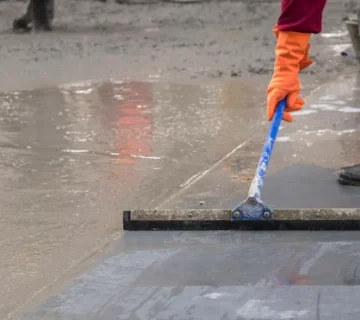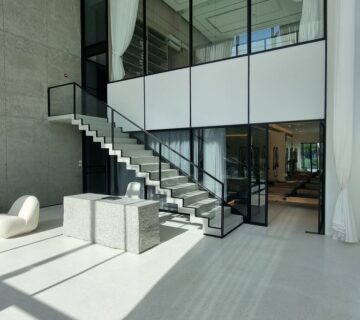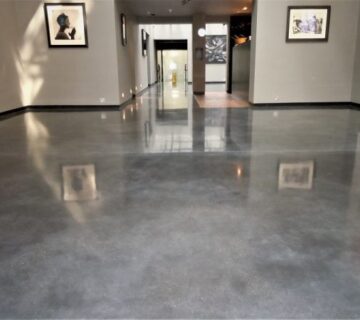Microcement has become a popular choice in modern interior design thanks to its sleek, seamless finish and industrial aesthetic.
When paired with underfloor heating, it not only looks stylish but also functions as an excellent thermal flooring system. This guide will walk you through how Microcement with underfloor heating works, its benefits, installation steps, and maintenance tips.
How Does Microcement Work with Underfloor Heating Systems?
Microcement with underfloor heating is an energy-efficient surface solution that works well due to its thin application and strong thermal conductivity. It efficiently transfers heat from the heating system to the surface, warming up rooms quickly and evenly. Its minimal thickness, usually around 2–3mm, means the heat doesn’t have to travel far, resulting in faster heat-up times and better temperature control.
Both electric and water-based radiant floor finish systems are compatible with Microcement. Whether it’s a dry (electric mat) or wet (hydronic) system, the material bonds well and maintains performance. Thanks to its seamless heated flooring design, Microcement eliminates the cold patches often found in traditional flooring materials.
Why Is Microcement a Suitable Finish Over Heated Floors?
There are several reasons why Microcement with underfloor heating is a top choice for contemporary homes. First, it’s highly durable and resistant to cracks when applied correctly. This makes it perfect for heated minimalist floors that are expected to endure regular thermal cycling. It also eliminates the need for expansion joints, creating a continuous, sleek finish ideal for open-plan spaces.
Because of its resilience against temperature changes, Microcement supports stable surface temperatures without warping or shifting. It’s a practical and stylish solution for modern thermal floors that prioritize both form and function.
What Are the Steps to Install Microcement on Heated Subfloors?
Proper installation is key to ensuring that Microcement performs well over an underfloor heating system. Here’s a step-by-step breakdown:
- Substrate Preparation: Ensure the surface is clean, dry, stable, and free of contaminants. Any movement or moisture can lead to delamination or cracking.
- Apply a Primer: A bonding agent is used to enhance adhesion between the subfloor and Microcement layers.
- Install Mesh (If Required): A fiberglass mesh may be embedded into the base layer for added flexibility and crack resistance.
- Apply Base and Finish Coats: Multiple microcement floor layers are applied, usually including two base coats followed by two finish coats.
- Seal the Surface: A high-quality sealer protects the cement overlay heating system from wear, moisture, and stains.
- Heating Protocol: The underfloor heating system should be turned off before application and only gradually restarted after the surface has fully cured (usually 7 days minimum).
Following these steps ensures the heat-conductive Microcement performs optimally for years.
How Do You Prevent Cracking or Delamination with Heated Microcement Floors?
To prevent issues like cracking or delamination, it’s essential to follow proper installation and heating protocols. Substrate stability plays a vital role. Any movement can lead to problems, especially when the surface is repeatedly heated and cooled. Using a flexible, heat-compatible Microcement product helps reduce this risk.
It’s also critical to follow the manufacturer’s recommendations regarding heating cycles. Sudden temperature changes can stress the cement, so always start the heating system slowly after curing.
Expansion behavior should be considered during planning. While Microcement doesn’t require expansion joints, proper subfloor conditions must be met to support its seamless finish under thermal stress.
What Rooms Are Best for Microcement and Underfloor Heating Combo?
Microcement with underfloor heating is an ideal pairing for various spaces in your home. Bathrooms and kitchens benefit from the warm, water-resistant surface, offering comfort and functionality in areas prone to moisture.
Living rooms and bedrooms are also great candidates, especially in homes that favor a minimalist or industrial aesthetic. Heated minimalist floors enhance the feeling of luxury while maintaining a clutter-free appearance.
For continuity, many designers extend Microcement from floors to walls, creating a cohesive visual flow and maximizing the benefits of a seamless heated flooring system.
How to Maintain a Microcement Floor with Radiant Heat?
Maintenance is straightforward if you follow the correct care routine. To preserve the surface:
- Use neutral pH cleaners and soft cloths or mops.
- Avoid harsh chemicals, abrasive pads, or strong acidic products.
- Reapply the protective sealer every 2–4 years depending on foot traffic and wear.
Thanks to its non-porous nature, Microcement doesn’t trap dust or allergens, making it an excellent energy-efficient surface for allergy-prone households.
Regular upkeep will keep your thermal flooring system in top shape without compromising its appearance or function.
Wrapping Up: Is Microcement with Underfloor Heating Right for Your Home?
Microcement with underfloor heating is a stylish, practical, and efficient solution for modern homes. Its energy-saving capabilities, seamless appearance, and comfort underfoot make it ideal for various interior spaces.
However, correct installation and curing processes are essential to ensure long-lasting results. Always consult experienced professionals who understand the demands of cement overlay heating systems.
Whether you’re renovating or building from scratch, this combo offers the perfect balance between beauty and performance.








No comment